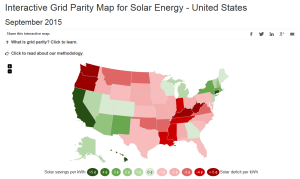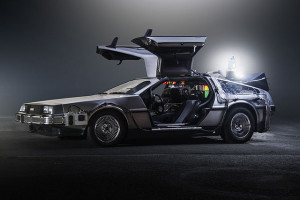Solar Energy and Electric Cars: The Future is Now

Original artwork by Ela G., age 6
Children growing up twenty, thirty, forty years ago might have imagined flying cars in the year 2015, as in the movie Back to the Future II, when Marty McFly and Doc Brown traveled forward to the 21st of October 2015, but I don't think many of them pictured houses with space-age reflective surfaces on the roof, harnessing the sun's energy so that they could power their home or plug in their car. As adults, they might have started to imagine that that scenario might become a reality in a not-so distant future, maybe ten or fifteen years from today. But that future is here now and it arrived much quicker than we could have imagined.
The growth of solar PV
According to the International Energy Agency, in 1992, the cumulative installed global PV capacity was 0.1 GW, while at the end of 2014, the total installed capacity worldwide was 177 GW. And by SEIA's estimation, by the end of the first quarter of 2015, the total installed capacity in the United States alone surpassed 20 GW. However, most of the growth in the U.S. and the rest of the world was led by utility-scale PV.

WhatNextNow Solar Interactive Grid Parity Map for Residential Solar in the U.S.
So how does that picture look when it comes to residential solar? Again according to SEIA, residential solar in the U.S. passed the 1 GW barrier for the first time, growing 51% in 2014 over 2013. Today, over 600,000 homes in the U.S. have solar PV installations.
A child playing in a neighborhood in Honolulu or San Diego might very well draw a picture of his/her home with solar panels on the roof. However, that's not necessarily the case across the entire U.S. where retail electricity rates and financial incentives differ from state to state. But the number of states that have reached grid parity (where solar electricity is the same or cheaper than electricity from the utility) has grown considerably over the past decade. Solar panels are becoming more and more of a common sight. According to SEIA, in 2004 only a couple of states had 10 MW of installed solar capacity, while a decade later, 35 states have topped that threshold, and 20 of them have more than 100 MW.
Much of the growth in the U.S. in the past decade is directly attributable to the federal solar investment tax credit (ITC) of 30%. Since the ITC's implementation in 2006, SEIA reports that the blended (utility-scale and residential-scale) average solar PV cost per watt has dropped by more than 73%. The ITC for residential solar is set to expire at the end of 2016 (with the commercial credit dropping from 30% to 10%). At this stage, it is still unclear how the industry will be affected. Almost certainly, there will be some sort of hiccup in the industry if the ITC is not extended, as many are hoping it will be, but with falling solar costs and rising utility rates, the future still looks pretty bright for residential solar in the U.S even without the ITC.
The electric car hits the streets

The DeLorean Time Machine - Image credit: Terabass
They may not be flying cars or time machines, but electric cars certainly represent a significant technological advance that could reduce our dependence on fossil fuels and help us meet our goals for a cleaner future. The first mass market all-electric vehicle was introduced in December 2010, so compared to solar PV, they haven't been on the scene for very long. But one thing they have going for them, that by comparison works against solar PV, is that they can, and do, make economic sense in states that haven't reached grid parity yet. Your car doesn't care whether it's being fueled by cheap hydro electricity, for example, or "free" solar electricity.
So have they taken off? According to the U.S. Office of Energy Efficiency and Renewable Energy, cumulative sales of plug-in all-electric vehicles in the U.S. alone reached 247,188 in August 2014. OK, so there are not as many electric vehicles out there as homes with solar PV, but the number of plug-in all-electric vehicles on the road is expected to jump to 1.5 million by 2020 according to forecasts by Navigant Research. This increase is in large part the result of gains made on the battery front. According to the Clean Energy Ministerial, since 2011, battery costs have dropped more than 50%, and energy density has also risen, improving vehicle range. With more affordable price tags in the coming years and increased consumer confidence, it won't be long before plug-in cars feature prominently in the work of young budding artists.
The future beyond the here and now
In twenty, thirty, forty years from now, what will children's art reflect about the world we live in? I had the pleasure some years ago of listening to James Dator, a professor of Futures Studies at the University of Hawaii, give a talk. He said something along the lines of:
If you can imagine what the world will look like decades from now, it's not likely to be that future that unfolds.
It's more often the things we fail to imagine that actually transpire. With the 21st of October 2015 finally upon us, I'm sure many people will be re-watching Back to the Future II to see what aspects of the future they got right and what they got wrong.
While, the movie-makers did imagine a world with ubiquitous screens, I don't think most people could have predicted the explosion in smart phones and how they have become pervasive in our lives, and yet here we are today with global smartphone shipments on the order of 1000 every 22 seconds, according to an article by The Economist. Yet, as that same Economist article reminds us, one man who got it right was Steve Jobs, back in 2007, when he launched the first smartphone and said "this will change everything."
Here's hoping that the next thirty years bring with it even more amazing developments in clean, green technology, so that our children have an even better reality from which to draw inspiration. Movie ideas anyone?
Sources:
Technology Roadmap Solar photovoltaic energy, IEA
2014 Snapshot of Global PV Markets, IEA
Installing 1,393 MW of PV in Q2 2015, U.S. Solar Market Surpasses 20 GW, SEIA
New Analysis Shows Huge Growth in Solar Over Past Decade, SEIA
Fact #843: October 20, 2014 Cumulative Plug-in Electric Vehicle Sales are Two and a Half Times Higher than Hybrid Electric Vehicle Sales in the First 45 Months Since Market Introduction, Energy.gov
EVI Releases the Global EV Outlook 2015, Clean Energy Ministerial
Executive Summary: Electric Vehicle Market Forecasts, Navigant Research
Planet of the phones: The smartphone is ubiquitous, addictive and transformative, The Economist
Back to the Future Day: What did the 1980s classic get right about 2015?, The Independent